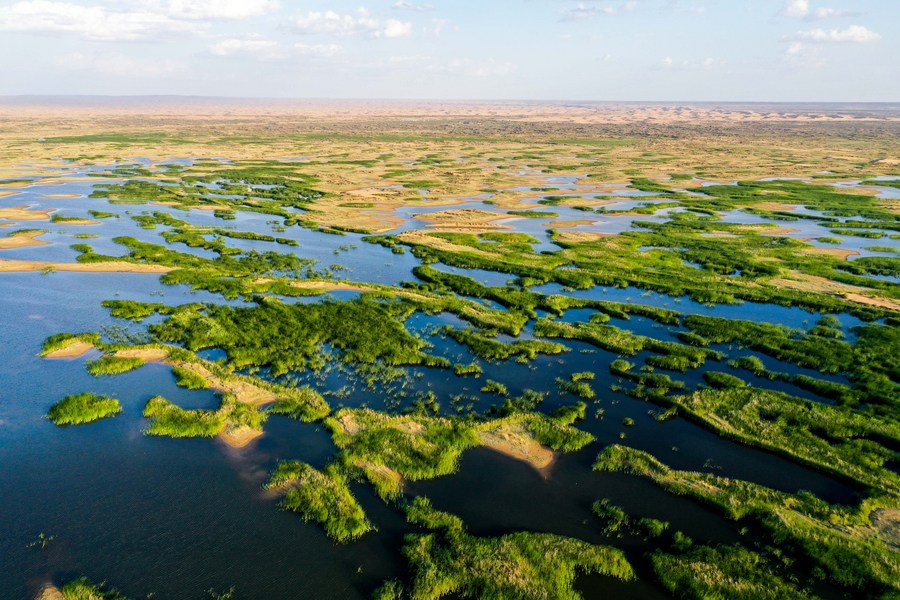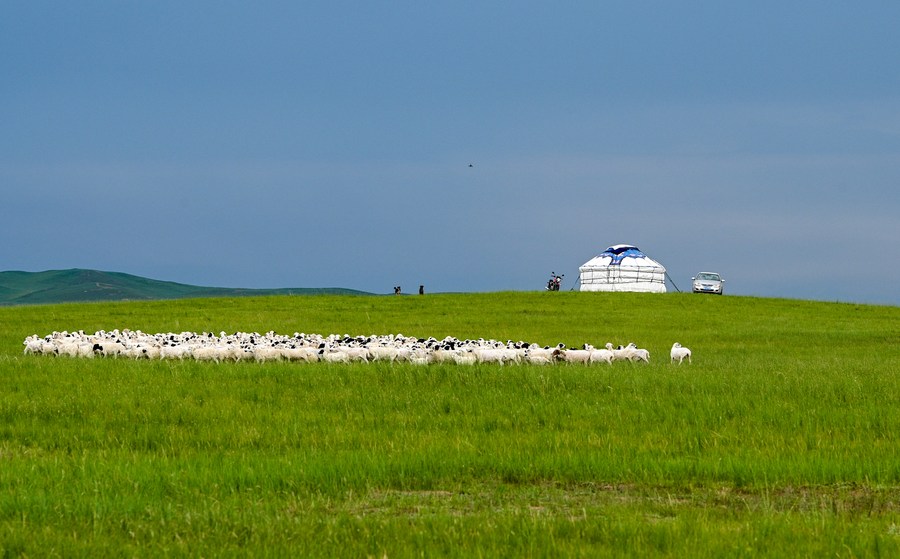

In August, luxuriant plants in north China's prairies are full of vitality. Hasbayar enjoys his daily work of riding a motorbike to drive his herd in his pasture.
"The vegetation grows better by the year," said the 52-year-old veteran herdsman in Ejinur Township, Xilingol League in north China's Inner Mongolia Autonomous Region.
The autonomous region spans the vast northern territory of China. Home to several large deserts, it is at the forefront of China's fight against desertification, and has been fueling its green drive to form an important ecological barrier in the country.

Aerial photo taken on Aug. 16, 2022 shows a view of the Kubuqi Desert in Hangjin Banner, north China's Inner Mongolia Autonomous Region. (Xinhua/Lian Zhen)
Boasting more than 5,000 mu (333.3 hectares) of contracted pasture in Xilingol grassland, Hasbayar has witnessed the region's comprehensive efforts in striking an ecology-economy balance.
Desertification and salinization began to erode his pasture more than 20 years ago in Xilingol grassland, which accounts for one-fourth of Inner Mongolia's total grassland area.
In 2011, China launched a grassland ecological protection program in eight provincial-level regions, including Inner Mongolia. Under the program, subsidies were given to herdsmen to compensate for their loss during the grazing suspension period, and rewards were provided as an incentive for those who could strike a balance between grazing and grassland protection.
The program made a change to the grassland. "After two or three years of implementing the program, I saw the volume and density of the vegetation in my pasture increase significantly," Hasbayar recalled.
Hasbayar has benefited from the program, too. He reduced the number of his sheep from more than 700 to about 400, and has been entitled with an annual incentive fund of more than 20,000 yuan (about 2,966 U.S. dollars).
Besides, more than 1,000 mu of his pasture was enclosed for harvesting autumn grass. "In addition to feeding my own herd, I also profit from selling grass to others," Hasbayar said.

A flock of sheep forage on Xilingol Grasslands in Xilingol League, north China's Inner Mongolia Autonomous Region, July 15, 2021. (Xinhua/Lian Zhen)
Since 2018, Xilingol League has imposed a grazing ban in spring, affecting more than 200 million mu of grassland and more than 86,000 herdsmen households. During the 45-day moratorium, the government appropriates over 1.1 yuan of grassland subsidy per mu to inhabitants for rehabilitating the grassland productivity. The method has been expanded to other grassland areas in Inner Mongolia, such as Ordos and Hulun Buir.
According to the regional authority, more than 1 billion mu of grasslands in Inner Mongolia have been covered by ecological protection measures such as the grazing ban program, benefiting over 1.4 million rural households.
In Xilingol, the stock of sheep has been reduced from 20 million at its peak to about 11 million at present, and that of cattle is now kept at around 2 million. This livestock production scale is within the grasslands' carrying capacity.
Technological measures have also been adopted to help rehabilitate degraded grassland areas.
Researchers at Inner Mongolia M-grass Ecology and Environment (Group) Co., Ltd. have conducted experiments on six grass strains that were taken onboard the Shenzhou-13 spaceship into space for six months. It was the second time that the company had sent seeds into space, following the return of grass species mutations with the Chang'e-5 lunar probe in 2020.

Photo taken on Sept. 9, 2021 shows an interior view of the bank of native plant germplasm resources of Inner Mongolia M-grass Ecology and Environment (Group) Co., Ltd., in Hohhot, north China's Inner Mongolia Autonomous Region. (Xinhua/Liu Lei)
The company has stored some of the seeds in its bank of native plant germplasm resources, and taken out the others for breeding research to create new germplasm with good characteristics such as tolerance, wide adaptability and high yield.
Chen Ruijue, brand director of the company, said that through cultivating grass seeds, along with synthetic saline-alkali and desertification control measures, the company has restored nearly 30,000 mu of degraded grassland area, where the average vegetation coverage now reaches 40 percent to 60 percent.
This year, M-grass has built 10,000 mu of high-quality forage grass base, known as Halgait Ranch in Xilingol. Seedlings cultivated here can be used for ecological restoration of up to 200,000 mu of grasslands in neighboring areas.
In addition to the grassland restoration, the regional authorities have carried out water ecological treatment in the Yellow River Basin since 2012.
Among a total of 35 surface water sections in the Yellow River in Inner Mongolia, 74.3 percent of the streams have stood above the third class on China's five-tier quality scale for surface water.
Hulun Lake, the largest lake in Inner Mongolia, has seen its water coverage expand from about 1,700 square km in 2012 to 2,242 square km this year, thanks to a series of comprehensive protection and restoration measures.
With restored wetland ecology, more fish and bird species have been recorded in and around Hulun Lake compared with a decade ago.
(Video Reporters: Wang Xuebing, Yu Jia, Zhao Zehui, Ha Lina, Wang Chunyan, He Shuchen; Video Editors: Wang Houyuan, Luo Hui, Hui Peipei.)
点击右上角![]() 微信好友
微信好友
 朋友圈
朋友圈

请使用浏览器分享功能进行分享
